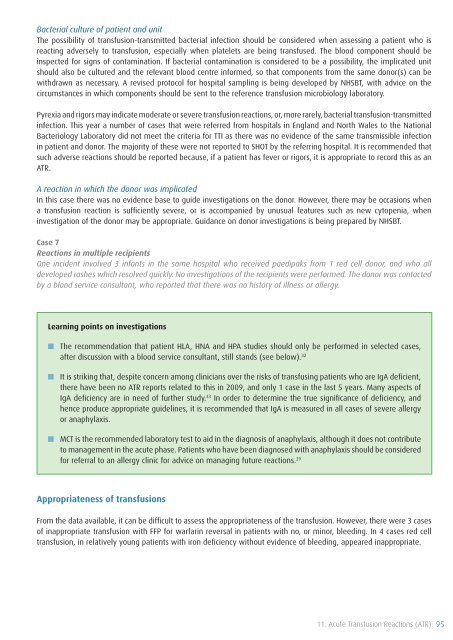SHOT Annual Report 2009 - Serious Hazards of Transfusion
SHOT Annual Report 2009 - Serious Hazards of Transfusion
SHOT Annual Report 2009 - Serious Hazards of Transfusion
You also want an ePaper? Increase the reach of your titles
YUMPU automatically turns print PDFs into web optimized ePapers that Google loves.
Bacterial culture <strong>of</strong> patient and unit<br />
The possibility <strong>of</strong> transfusion-transmitted bacterial infection should be considered when assessing a patient who is<br />
reacting adversely to transfusion, especially when platelets are being transfused. The blood component should be<br />
inspected for signs <strong>of</strong> contamination. If bacterial contamination is considered to be a possibility, the implicated unit<br />
should also be cultured and the relevant blood centre informed, so that components from the same donor(s) can be<br />
withdrawn as necessary. A revised protocol for hospital sampling is being developed by NHSBT, with advice on the<br />
circumstances in which components should be sent to the reference transfusion microbiology laboratory.<br />
Pyrexia and rigors may indicate moderate or severe transfusion reactions, or, more rarely, bacterial transfusion-transmitted<br />
infection. This year a number <strong>of</strong> cases that were referred from hospitals in England and North Wales to the National<br />
Bacteriology Laboratory did not meet the criteria for TTI as there was no evidence <strong>of</strong> the same transmissible infection<br />
in patient and donor. The majority <strong>of</strong> these were not reported to <strong>SHOT</strong> by the referring hospital. It is recommended that<br />
such adverse reactions should be reported because, if a patient has fever or rigors, it is appropriate to record this as an<br />
ATR.<br />
A reaction in which the donor was implicated<br />
In this case there was no evidence base to guide investigations on the donor. However, there may be occasions when<br />
a transfusion reaction is sufficiently severe, or is accompanied by unusual features such as new cytopenia, when<br />
investigation <strong>of</strong> the donor may be appropriate. Guidance on donor investigations is being prepared by NHSBT.<br />
Case 7<br />
Reactions in multiple recipients<br />
One incident involved 3 infants in the same hospital who received paedipaks from 1 red cell donor, and who all<br />
developed rashes which resolved quickly. No investigations <strong>of</strong> the recipients were performed. The donor was contacted<br />
by a blood service consultant, who reported that there was no history <strong>of</strong> illness or allergy.<br />
Learning points on investigations<br />
■■<br />
The recommendation that patient HLA, HNA and HPA studies should only be performed in selected cases,<br />
after discussion with a blood service consultant, still stands (see below). 32<br />
■■ It is striking that, despite concern among clinicians over the risks <strong>of</strong> transfusing patients who are IgA deficient,<br />
there have been no ATR reports related to this in <strong>2009</strong>, and only 1 case in the last 5 years. Many aspects <strong>of</strong><br />
IgA deficiency are in need <strong>of</strong> further study. 33 In order to determine the true significance <strong>of</strong> deficiency, and<br />
hence produce appropriate guidelines, it is recommended that IgA is measured in all cases <strong>of</strong> severe allergy<br />
or anaphylaxis.<br />
■■ MCT is the recommended laboratory test to aid in the diagnosis <strong>of</strong> anaphylaxis, although it does not contribute<br />
to management in the acute phase. Patients who have been diagnosed with anaphylaxis should be considered<br />
for referral to an allergy clinic for advice on managing future reactions. 29<br />
Appropriateness <strong>of</strong> transfusions<br />
From the data available, it can be difficult to assess the appropriateness <strong>of</strong> the transfusion. However, there were 3 cases<br />
<strong>of</strong> inappropriate transfusion with FFP for warfarin reversal in patients with no, or minor, bleeding. In 4 cases red cell<br />
transfusion, in relatively young patients with iron deficiency without evidence <strong>of</strong> bleeding, appeared inappropriate.<br />
11. Acute <strong>Transfusion</strong> Reactions (ATR) 95












